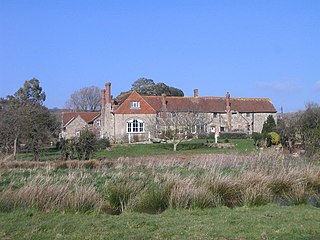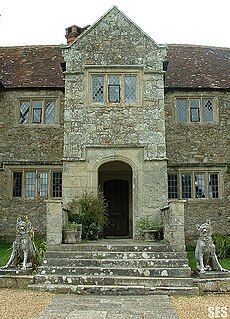
Sway is a village and civil parish in Hampshire in the New Forest national park in England. The civil parish was formed in 1879, when lands were taken from the extensive parish of Boldre. The village has shops and pubs, and a railway station on the South Western Main Line from Weymouth and Bournemouth to Southampton and London Waterloo. Sway is on the southern edge of the woodland and heathland of the New Forest. Much of the children's novel The Children of the New Forest is set in the countryside surrounding Sway.

Staplers is a suburb of Newport, Isle of Wight, England, on the east side of the River Medina.

Haseley Manor is a 14th-century, Grade 2* listed property located in Arreton on the Isle of Wight.

Arreton Manor is a manor house in Arreton, Isle of Wight, England. Its history is traced to 872 AD to the time of King Alfred the Great and his parents. It was left by King Alfred by his will to his youngest son Aethelweard. Once owned by William the Conqueror, as mentioned in the Domesday Book in 1086, in the 12th century it became part of Quarr Abbey and was used by the monks for over 400 years. In 1525 it was leased to the Leigh family. The manor was rebuilt between 1595 and 1612. Built in Jacobean style, it is in the shape of a "H". It is also widely known on the Isle of Wight in folklore for its paranormal activity, particularly the ghost of a young girl named Annabelle Leigh who was murdered at the manor by her own brother in 1560.

The Great Budbridge Manor is a manor house just south of Merstone, near Arreton, Isle of Wight, England. Fish ponds on the grounds appear medieval.
Langbridge Manor is a manor house on the Isle of Wight, situated within the Newchurch parish. It was historically linked with Ashey Manor.
Bigbury Manor is a small manor house on the Isle of Wight within the Newchurch parish. It is a small holding to the north of Apse Heath, was confirmed to Quarr Abbey by Isabel de Fortibus, and remained in the possession of the abbey until the Dissolution of the monasteries, when it passed to the Crown. It was granted in 1610 to Lionel Cranfield,. In 1631 Basil Nicoll and others obtained a grant of the messuage or grange of Bidborowe.
Wroxall Manor was a manor house on the Isle of Wight, situated in the Newchurch parish.
Briddlesford Manor, is a manor house on the Isle of Wight, situated in the parish of Arreton.
Hale Manor is a manor house on the Isle of Wight, situated in the parish of Arreton. It forms the south-eastern portion of the parish adjoining Newchurch, and comprises the high ground to the south of the River Yar above Horringford.
Horringford Manor is a manor house on the Isle of Wight, situated in the parish of Arreton.
Huffingford Manor is a manor house on the Isle of Wight, situated in the parish of Arreton.
Rookley Manor is a manor house on the Isle of Wight, situated in the parish of Arreton. Though originally in Godshill parish, it is now included for the greater part in the boundaries of South Arreton.
Staplehurst Manor was a manor house on the Isle of Wight, situated in the parish of Arreton.
Durton Manor was a manor house on the Isle of Wight, situated in the parish of Arreton.
Perreton Manor is a manor house on the Isle of Wight, situated in the parish of Arreton.
Redway Manor is a manor house on the Isle of Wight, situated in the parish of Arreton.
Luccombe Manor was a manor house on the Isle of Wight, situated in the parish of Bonchurch.







